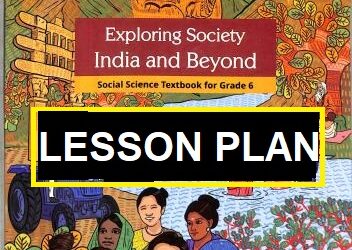Class VI Civics Chapter 4 Lesson Plan
Civics class VI Chapter 4 Lesson plan “key elements of a Democratic Government” is an activity that a teacher has to perform before the actual teaching takes place. It is the road map for any teacher. Moreover, effective lesson planning provides the students with the necessary structure and direction. It also takes care of the diverse needs of our students. Class VI Civics Chapter 4 Lesson plan provides better resources that are integral to students. This lesson plan of class VI is full of classroom activities that children will enjoy doing. It will also allow teachers to critically reflect on and improve our teaching and learning practice. It ensures every minute of class time in teaching new concepts. This lesson plan will help you to reach every child with a clear plan in mind.
key elements of a Democratic Government Lesson Plan
General Objective:
Firstly, to develop an interest in the subject.
Secondly, to prepare young learners to participate in civic society.
Thirdly, encourage students to participate in public affairs.
Finally, to provide basic knowledge and understanding of the government to the children.
Specific Objective:
- Initially, Students will acquire knowledge about the key elements of government.
- Moreover, They will be able to relate the work of government.
Application:
- Firstly, Students will be able to use this knowledge in real-life situations.
- Secondly, They will feel motivated to follow the rules and regulations of their country.
Teaching aids:
Text Book, Black Board, smart board, Chart Paper.
Checking Previous Knowledge:
At first, the teacher checks the previous knowledge of the students by asking a question.
Teacher: What is Democracy?
Student’s response: Democracy is of the people, for the people, and by the people.
Teacher: There are how many types of democracy?
Student’s answer: different answers 2, 1, 3, 5, 3, 3, 1, 3………
Teacher: In a democracy, who is powerful – people or the government?
Student’s answer: People.
Teacher: O.K. Have you ever heard about the “Key elements of a Democracy“?
Student’s response: No.
Statement of Topic
Today we are going to study the “Key elements of a Democracy“?
key elements of a Democratic Government Lesson Plan
Teaching Method: Interactive
First, the teacher plays an interesting video on the smart board.
Technique:
To begin with, the teacher begins with an Interactive session with common examples.
However, the teacher uses various methods to make the topic interesting by interacting with the children in the class.
By asking very simple questions, the teacher draws the attention of the class.
Finally, also make sure that the children are involved in the discussion.
Therefore, While interacting with the students, the teacher also tells about the “Key elements of a Democracy“?
Content/ Teaching Points:
- Introduction
- Participation
- Other ways of participating
- Need to resolve conflict.
- Equality and Justice.
Class VI Civics Chapter 4 Lesson Plan
First Activity: Day 1
Topic: Role of Government
Objective: To understand the various role played by the Government.
Duration: 20 minutes.
Procedure:
- i) Students will be asked to bring a newspaper from home.
- ii) List the activities that the Government is reported to be doing.
- a) ……………………..
- b) ……………………
- c) ……………………
- d) ……………………
Learning outcome:
Finally, Students will learn and understand the various types of work done by the Government.
Skills Developed:
Observation and thinking skills
It will be a classroom activity that will not be assessed.
Classwork:
- i) Initially, short answer type questions will be done.
- ii) Later on, Long answer type questions will be discussed and done in the class.
Homework:
- i) Read about Nelson Mandela.
- ii) Read stories on equality and justice.
Values imparted:
- To respect differences.
- Respecting diversity, equality, and justice.
Multidisciplinary Integrated learning:
- English/Hindi: write a paragraph on people’s participation in government.
- History: Read about a king who was known for justice. Read about Jahangir.
Assessment Criteria:
Indicators
- Relevance of Content
- Presentation of information gathered
- Awareness of the information gathered
- Creativeness
- Analytical Skills
Learning Outcome:
After the completion of this chapter, students will be able to
- Firstly, explain different terms like apartheid, equality, and justice.
- Secondly, explain the key elements of democratic government.
- Thirdly, get familiar with the participation of people.
Remedial Measure:
Extra Class
The teacher asks the slow learners to stay after school hours for personal attention.
Class VI Civics Chapter 4 Lesson Plan
Conclusion:
I hope You will find Class VI Civics Chapter 4 Lesson plan on “key elements of a Democratic Government” of great help. Here in this Class VI Civics Chapter 4 Lesson plan, we have included only single chapter from History. We have tried to keep our lesson plan teacher and student-friendly. I Hope, this Class VI Civics Chapter 4 Lesson plan caters to the need of every child. Students will love performing these activities which will make the class lively and interesting.
As a teacher, if you have conducted any interesting classroom activity, do write to me so that I can include it in my next post.
You may like to read other popular posts:
Class VI History Chapter 7 Lesson Plan: Ashoka, The Emperor Who Gave Up War
If any teacher wants to write a guest post can mail it to me. Your article will be published in your name with your photograph on my website. Was this article helpful to you in anyway. Pl. do not hesitate to write your honest feedback in the comment box given below.





0 Comments